Follow the ancient paths of prophets and kings in the Negev, where biblical history and mystery await your discovery.
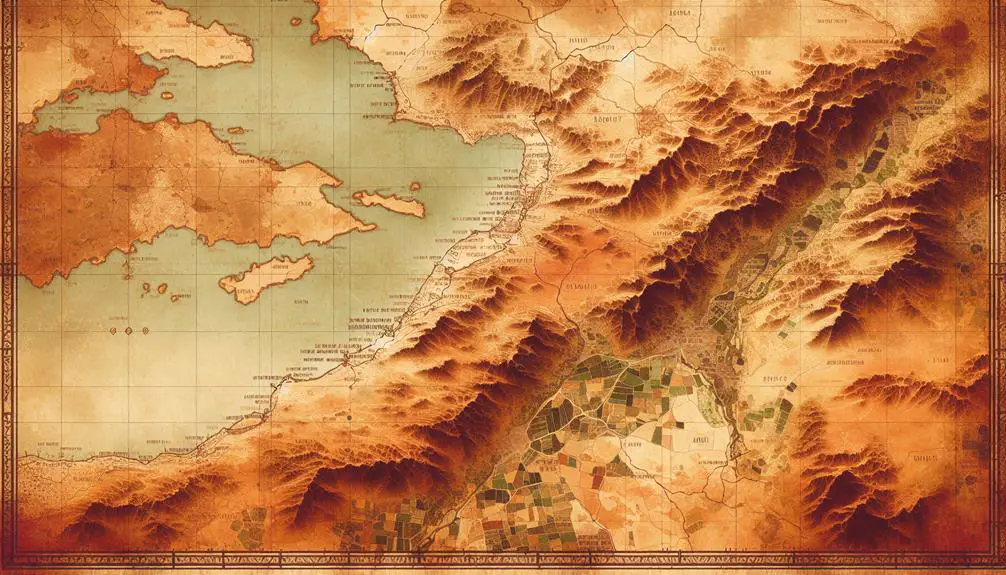
Map of Negev in the Bible
Imagine the sweeping sands and rocky terrains of the Negev, a vast desert that cradles stories of faith, battles, and prophecy within its arid embrace.
You're about to embark on a journey through time, tracing the steps of Abraham and the Israelites, exploring ancient oasis towns, and uncovering the significance of key biblical locations like Beersheba and Kadesh.
The Negev's biblical map is not just a recount of historical events; it's a testament to enduring faith and the birthplace of narratives that have shaped civilizations.
Unraveling its layers will offer you a unique glimpse into the past, inviting you to explore how this ancient desert continues to influence the present.
Key Takeaways
- The Negev was a vital crossroads and setting for numerous biblical events, showcasing the region's historical and spiritual significance.
- Abraham's and the Israelites' journeys in the Negev emphasize the challenges of desert navigation and the reliance on divine guidance.
- Oasis towns in the Negev served as critical hubs for trade, agriculture, and cultural exchange, highlighting ancient engineering and resilience.
- Historical sites like Beersheba and Kadesh played pivotal roles in biblical narratives, reflecting the deep connection between the people and the land.
The Negev's Biblical Significance
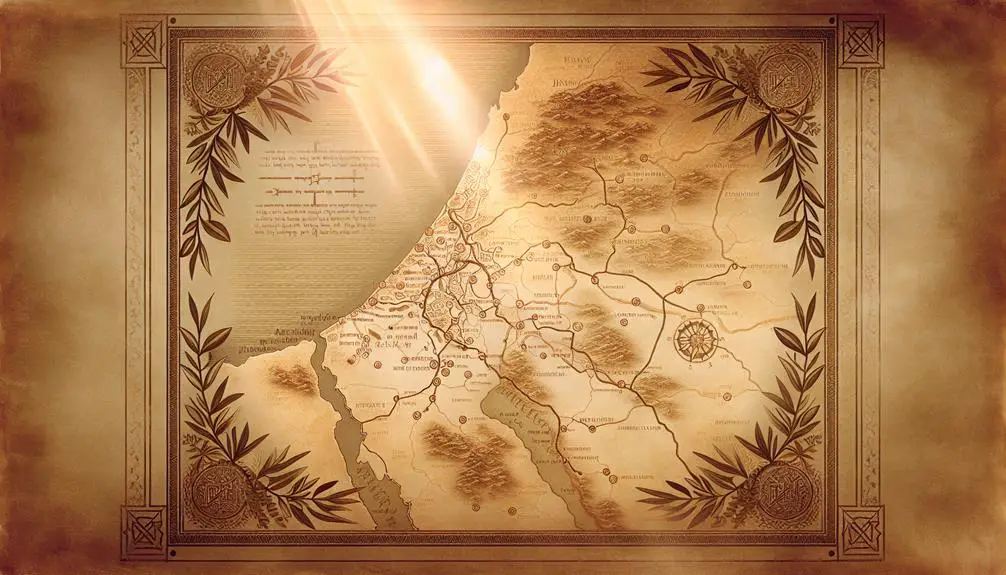
Exploring the Negev's role in biblical narratives reveals its pivotal position as a crossroads of ancient civilizations and a key setting for numerous biblical events. Geological studies of the Negev highlight its unique landscape, shaped over millennia, offering vital clues to understanding the environmental challenges faced by those ancient societies. The Negev's arid environment, characterized by its desert terrain, demanded innovative strategies for climate adaptation, which are subtly reflected in the biblical texts.
The adaptation strategies employed by ancient inhabitants, such as water conservation and agricultural techniques, underscore the Negev's significance not just as a backdrop, but as an active participant in the biblical narrative. These insights allow you to appreciate the complexity of life in this region and the ingenuity of its people in overcoming the harsh conditions.
Moreover, the geological and climatic studies of the Negev provide a deeper understanding of how these environmental factors influenced the events and stories chronicled in the Bible. It's a testament to the resilience and adaptability of those who lived in the Negev, making it a key player in the unfolding of biblical history.
Abraham's Journeys in the Negev
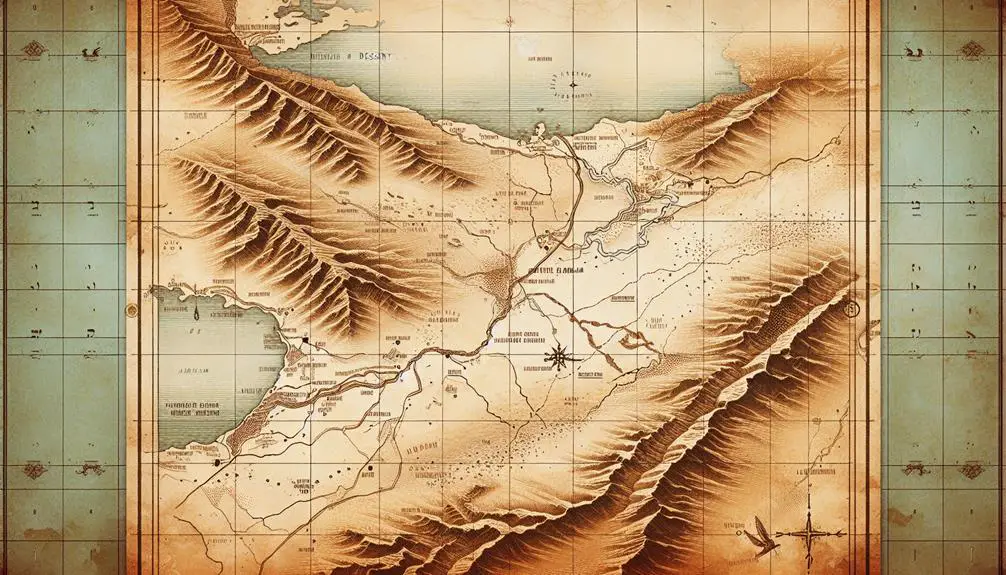
Building on the understanding of the Negev's environmental and historical significance, let's examine how Abraham's journeys through this arid landscape illuminate his role in biblical narratives and the adaptive strategies he might've employed. Abraham's sojourns in the Negev, a region characterized by its harsh desert conditions, underscore his reliance on desert hospitality for survival. This hospitality wasn't merely a cultural nicety but a critical lifeline in the vast, unforgiving terrain.
Abraham's interactions with local tribes and communities, as recorded in Genesis, highlight the significance of forming alliances and mutual support systems. These encounters often culminated in covenant ceremonies, which weren't only spiritual milestones but also strategic moves ensuring his clan's safety and access to resources. Such ceremonies, deeply embedded in the social fabric of the time, served to formalize relationships and obligations among disparate groups, essential for navigating the complexities of desert living.
Through these narratives, we gain insights into the sophisticated strategies Abraham employed to adapt to the Negev's challenges. His journeys reveal a profound understanding of the interplay between faith, diplomacy, and survival in an environment where the margin for error was slim.
The Israelites' Desert Wanderings
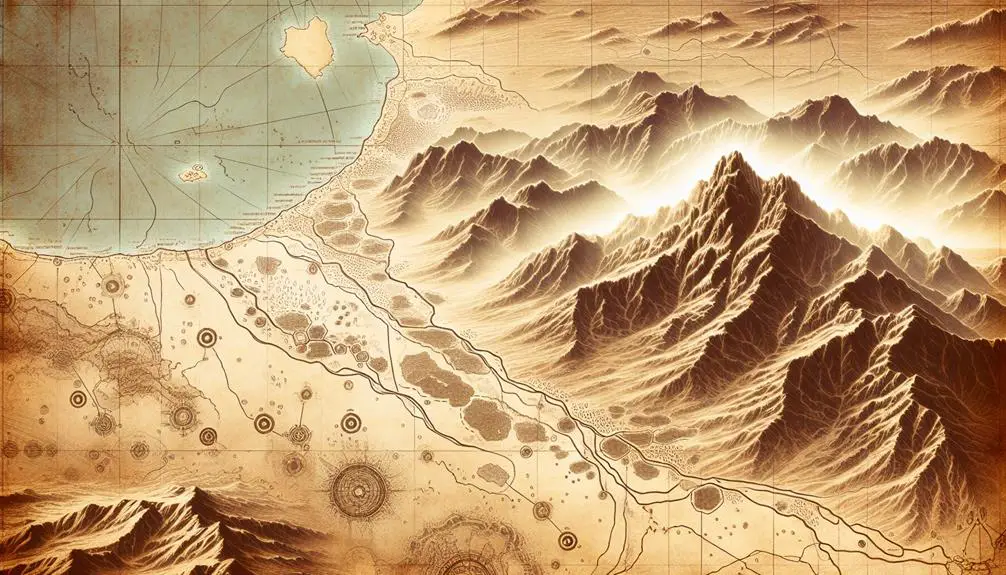
As you explore the Israelites' desert wanderings, you'll confront the complexities in determining their exact route through the Negev. Scholars have pinpointed key encampments based on textual and archaeological evidence, revealing a nuanced tapestry of movement.
Significantly, analyses underscore the role of divine guidance as depicted in biblical narratives, shaping the Israelites' journey both spiritually and physically.
Route Determination Challenges
How did the Israelites navigate the formidable challenges of determining their route through the vast, shifting desert landscape of the Negev during their wanderings? Modern navigation tools, which offer precision and reliability, starkly contrast the ancient methods, highlighting the magnitude of geographic discrepancies they faced. Without digital maps or GPS, the Israelites relied on natural landmarks and celestial navigation, a method far from foolproof in a landscape where sand dunes shift and oases are mirages.
- Disorientation: The constant change in the desert's appearance led to confusion and misdirection.
- Resource Scarcity: Finding water and food determined their path, often leading to unpredictable detours.
- Spiritual Guidance: Belief in divine intervention played a crucial role, yet it didn't negate the physical and emotional toll of uncertainty.
These challenges evoke a deep respect for their resilience and faith amidst overwhelming unknowns.
Key Encampments Identified
Navigating the vast Negev desert, the Israelites established key encampments, each marking a pivotal moment in their journey and serving as a testament to their resilience and strategic adaptability. These locations, chosen with a keen eye on geological features, offered not just physical respite but strategic advantages against potential adversaries.
Modern parallels draw attention to how these ancient choices mirror contemporary understanding of desert survival and mobility. For instance, oases and rock formations that provided ancient travelers with water and shelter continue to guide modern desert navigation. By analyzing sediment layers and rock inscriptions, scholars reconstruct these routes, offering insights into the Israelites' journey.
This meticulous mapping reveals a blend of survival instinct, strategic selection, and an intimate knowledge of the terrain, underpinning the enduring legacy of these encampments in the collective memory of a people.
Divine Guidance Role
Throughout the Israelites' desert wanderings, divine guidance played a pivotal role in directing their path, influencing both their physical journey and spiritual evolution. This guidance wasn't merely about navigating the physical landscape but also about fulfilling a deeper covenant promise between the divine and the Israelites. Here are three key aspects of this divine guidance:
- Miraculous Provisions: The Israelites received sustenance and protection, reinforcing the tangible presence of divine care.
- Covenant Promises: The journey was a physical manifestation of a spiritual covenant, emphasizing a promised land and a chosen people.
- Moral and Spiritual Lessons: Through challenges, the community learned obedience, faith, and trust, which were crucial for their identity and relationship with the divine.
Analyzing these elements reveals the profound impact of divine guidance on the Israelites' trajectory, both physically across the Negev and spiritually.
Key Locations: Beersheba and Kadesh
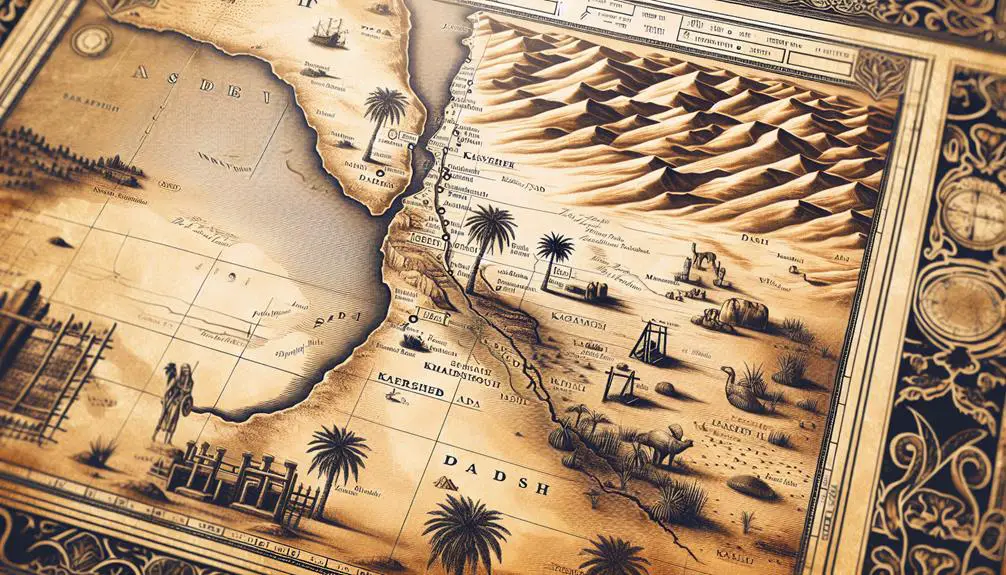
You'll find that Beersheba holds profound biblical significance, acting as a pivotal scene for numerous patriarchal narratives.
Conversely, Kadesh emerges as a critical locale in the Israelites' wilderness wanderings, marking a site of rebellion and divine encounters.
Analyzing these locations unveils layers of historical and theological import, deepening our understanding of their roles in biblical narratives.
Beersheba's Biblical Significance
In examining the biblical significance of Beersheba, it's crucial to note that this location, along with Kadesh, played pivotal roles in the narratives of the patriarchs and their covenants with God. Modern Beersheba, through advanced archaeology techniques, has unearthed artifacts that corroborate these biblical accounts, offering a tangible connection to these ancient stories.
Consider the emotional resonance evoked by:
- The discovery of ancient wells, aligning with the biblical narrative of Abraham's treaty.
- Artefacts that suggest a vibrant community, echoing the biblical depiction of familial and tribal gatherings.
- The realization that walking the same ground as the patriarchs bridges millennia, connecting us to our spiritual heritage.
This scholarly analysis underlines the profound interplay between faith, history, and archaeology, enriching our understanding of Beersheba's biblical significance.
Kadesh: Wilderness Wanderings
Among the narratives of Israel's desert wanderings, the accounts centered around Kadesh bear significant theological and historical weight, serving as pivotal landmarks in the collective memory of the Jewish people. You'll find that Kadesh isn't just a geographical location; it's a testament to survival, faith, and the complex tribal divisions that characterized early Israelite society.
Aspect |
Description |
Biblical References |
|---|---|---|
Location |
Near the border of Edom; critical water source |
Numbers 20:1 |
Significance |
Site of rebellion, faith tests, leadership challenges |
Numbers 27:14 |
Water Sources |
Miraculous provision of water |
Numbers 20:11 |
Tribal Divisions |
Staging ground for allocation of land |
Numbers 34:4 |
Kadesh's stories encapsulate themes of leadership, faith, and the quest for a promised land, underscored by the struggle to secure vital water sources and navigate tribal divisions.
The Negev's Oasis Towns
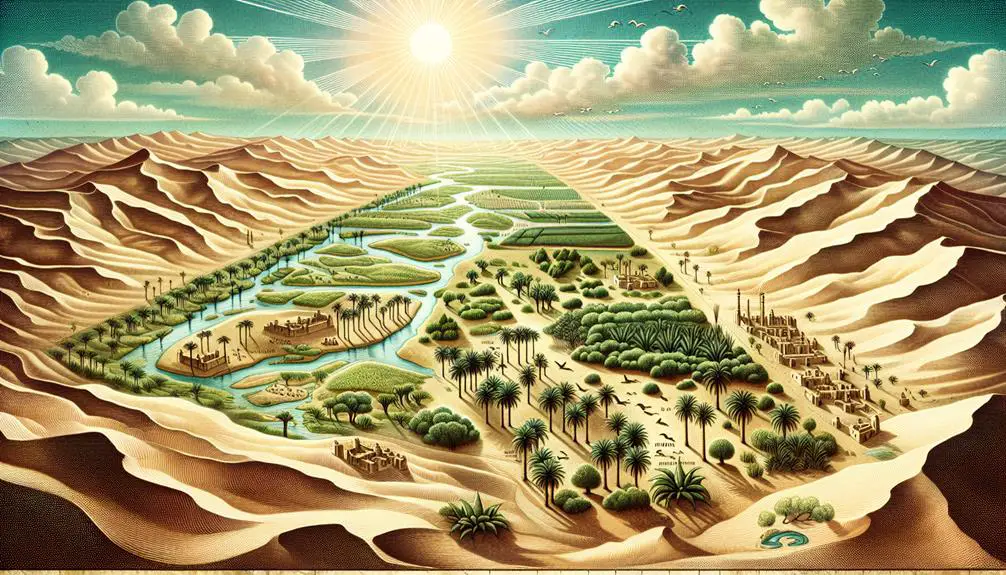
Exploring the Negev reveals that its oasis towns served as crucial hubs for trade, agriculture, and cultural exchange in the biblical era. These enclaves, nestled amidst harsh desert landscapes, harnessed innovative water technology and desert agriculture techniques to flourish. By devising sophisticated methods to collect, store, and redistribute water, these communities transformed seemingly inhospitable terrains into fertile grounds, capable of supporting both the local population and facilitating trade routes across the desert.
Understanding the significance of these oasis towns reveals:
- Innovation in Adversity: The ingenuity in water technology wasn't merely a matter of survival but a testament to the resilience and adaptability of the people who lived there. They turned the challenge of the desert into an opportunity, crafting a network of flourishing towns.
- Cultural Melting Pots: These towns became bustling centers where different cultures, traders, and travelers converged, exchanged goods, stories, and knowledge, enriching the social fabric of the region.
- Agricultural Marvels: The success in desert agriculture, growing crops in arid conditions, was a marvel of ancient engineering and botany, showcasing an intimate understanding of the natural world and its potential for sustenance.
The Negev's oasis towns are a testament to human ingenuity, embodying the spirit of innovation and resilience in the face of environmental challenges.
Battles and Conquests
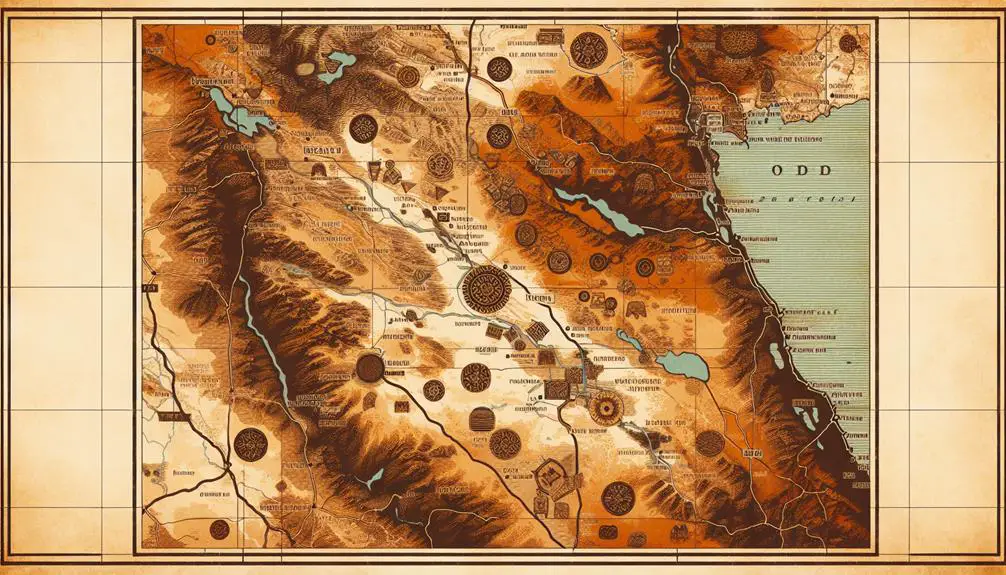
While the oasis towns of the Negev showcased human ingenuity in creating life-sustaining environments, they also became focal points for numerous battles and conquests throughout biblical history. You'll find that these areas weren't just crucial for their agricultural and water resources but also played significant roles in military strategies.
The Negev's strategic position attracted various empires, notably during the Roman campaigns. The Romans, understanding the region's importance, engaged in several military operations to secure their control over this arid yet vital territory. Their efforts to dominate the Negev underscored the area's significance in ancient geopolitical strategies.
Under Ottoman rule, the Negev once again became a battleground. The Ottomans, with their expansive empire, sought to fortify their presence in the region, leading to conflicts aimed at suppressing local revolts and consolidating power. The Negev's geography made it a challenging but essential area for the Ottomans to control, highlighting its enduring importance throughout history.
Period |
Significance |
|---|---|
Roman Campaigns |
Marked by military operations to secure control over the Negev's strategic points. |
Ottoman Rule |
Characterized by efforts to fortify presence and suppress local revolts in Negev. |
Prophets and Prophecies
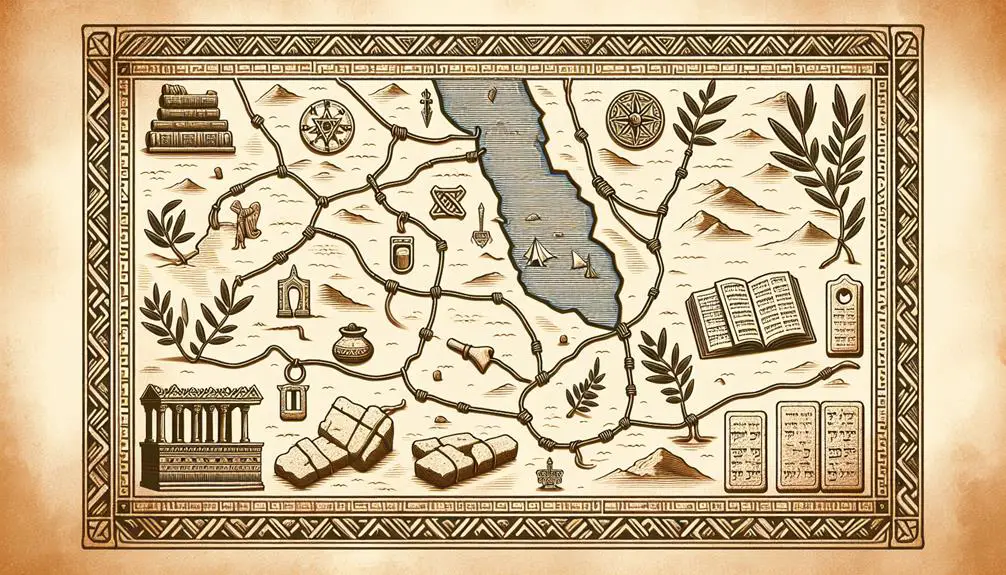
How did the prophets and their prophecies shape the spiritual and social landscape of the Negev in biblical times? The Negev, a desert region, wasn't just a backdrop for these narratives but a crucial participant. Prophets, acting as intermediaries between the divine and the people, influenced the Negev's history profoundly through miraculous interventions and vision interpretations, guiding communities through periods of turmoil and uncertainty.
- Miraculous interventions played a pivotal role in survival and settlement patterns, as prophets reportedly harnessed divine powers to provide water or repel invaders, directly impacting the region's demographic composition.
- Vision interpretations offered by prophets helped shape the moral and ethical framework of societies, guiding leaders and laypeople alike in making decisions that resonated with divine will, thereby influencing the social fabric of the Negev.
- The prophets' teachings and actions fostered a deep sense of community and belonging, rallying people together during times of crisis and celebration, thus embedding a rich spiritual heritage in the Negev's arid landscapes.
Analyzing the prophets' contributions to the Negev's spiritual and social spheres underscores their pivotal role in the region's historical narrative, demonstrating their enduring influence on its cultural and religious identity.
The Negev Today: Archaeology and Faith

Today's Negev stands as a testament to an intricate blend of ancient faith and modern archaeology, shedding light on how historical narratives and religious practices have shaped this region over millennia. You'll find that modern agriculture and the impacts of tourism are now intertwined with the region's deep-rooted religious significance, creating a complex landscape that both preserves and evolves its historical essence.
Archaeological endeavors in the Negev have unearthed relics that affirm the region's biblical references, offering tangible links to stories once confined to sacred texts. These discoveries not only enrich our understanding of ancient lifestyles and rituals but also highlight the Negev's role as a cradle of monotheistic faiths.
Moreover, the advent of modern agriculture has transformed parts of the Negev, demonstrating a harmonious blend of innovation and tradition. This hasn't only reshaped the physical landscape but also the economic and social fabric of the area, with communities adapting to new ways of life while holding onto their ancestral heritage.
Simultaneously, the surge in tourism, driven by an interest in the region's archaeological sites and spiritual significance, presents both opportunities and challenges. It fosters a broader appreciation for the Negev's historical and religious importance but also necessitates careful management to preserve its sacred and archaeological integrity.
Frequently Asked Questions
How Has the Climate of the Negev Changed Since Biblical Times, and What Impact Has This Had on Its Historical and Current Settlements?
Since biblical times, the Negev's climate has become drier, pushing communities to innovate in water conservation and desert agriculture. This shift has profoundly influenced both historical and current settlements.
You've seen populations adapt by developing sophisticated irrigation systems and drought-resistant crops, ensuring survival in harsh conditions. These changes haven't only allowed for continued habitation but have also turned the Negev into a modern study in resilience and sustainability amidst climate challenges.
Can the Flora and Fauna Mentioned in the Bible Regarding the Negev Be Found Today, and What Does This Tell Us About Environmental Changes?
You're looking into whether the flora and fauna from biblical times still roam the Negev. Interestingly, some species have adapted or migrated, reflecting significant environmental changes.
Plant adaptation and animal migration are key indicators of how ecosystems respond to climate shifts. This phenomenon highlights the resilience and adaptability of nature, offering insights into ancient and contemporary ecological dynamics.
It's a fascinating study on survival amidst evolving landscapes.
How Have Modern Geopolitical Boundaries Affected the Access and Preservation of Biblical Sites Within the Negev?
Modern geopolitical boundaries have significantly impacted access to and preservation of biblical sites within the Negev. Border disputes often restrict entry, limiting both research and tourism.
Additionally, the tourism impact, while beneficial economically, sometimes poses threats to these ancient sites' integrity. Careful management is crucial to balance access with conservation, ensuring these historical locations remain intact for future generations to explore and understand their profound historical and cultural significance.
In What Ways Have Contemporary Interpretations of the Bible Influenced the Archaeological Exploration and Understanding of the Negev?
Contemporary interpretations of ancient texts are reshaping your understanding of history. In the Negev, textual analysis and artifact dating serve as critical tools.
You're seeing scholars delve into the Bible with fresh eyes, influencing how they approach archaeological digs. This nuanced reading not only enriches the narrative of the Negev but also challenges and expands the historical context, offering a more detailed landscape of past civilizations through a scholarly, analytical lens.
What Role Does the Negev Play in the Cultural and Religious Practices of Communities Not Directly Related to the Abrahamic Faiths?
The Negev plays a pivotal role in the cultural and religious practices of various communities through its influence on desert spirituality and the impact of ecotourism.
You'd find that it serves as a unique backdrop for spiritual retreats and ceremonies, transcending Abrahamic faiths. Its vast landscapes and harsh conditions foster a deep connection to nature, encouraging practices that emphasize sustainability and the profound spiritual experience of solitude and contemplation.
Conclusion
In wrapping up, it's clear that the Negev's tapestry is richly woven with historical and spiritual threads, embodying Abraham's faith, Israelite trials, and prophetic visions. Key sites like Beersheba and Kadesh anchor its biblical narrative, while archaeological finds continue to illuminate its past.
As the saying goes, 'where history sleeps, legends whisper,' the Negev stands as a testament to enduring faith amidst desolation. Its story, deeply analyzed, bridges ancient tales and contemporary beliefs, inviting ongoing exploration and reverence.



Sign up